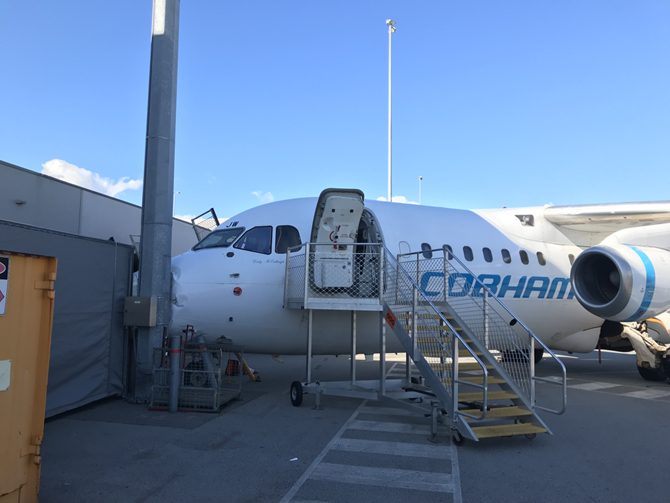Aircraft Collision Underscores Importance of Vigilance During Checks

Rolling the dice with safety: poor execution of checklists & independent checks.
On July 30, 2019, the flight crew of a Cobham Aviation Avro RJ85 was preparing its aircraft for departure from Perth Airport, a charter flight with two cabin crew and 62 passengers on board — but did this prep include checks and checklists?
The ineffective execution of checklists and the absence of nose-wheel chocking contributed to the airliner rolling forward after engine start and colliding with aircraft stairs and a light pole, a new ATSB (Australian Transportation Safety Board) report details.
The ATSB report reveals that a dispatch engineer at the Perth Airport warned the flight crew from his headset six times in five seconds—with an “increasingly urgent tone”—to check the brakes after the aircraft started rolling.
The West Australian informs us that “The Cobham flight was carrying FIFO workers to the Granny Smith gold mine near Laverton on July 30 when the incident occurred” and that ‘This investigation highlights the importance of ensuring all checklist items are addressed,’ the ATSB said.”
What was found in the investigation?
The subsequent ATSB investigation found that the flight crew did not effectively check the brake system pressure during two separate pre-flight checklists, which meant they did not detect that there was insufficient pressure within the braking system and did not identify that the system needed to be pressurized prior to engine start. (The aircraft had been parked after its previous flight for a number of hours; longer than the brake accumulator reservoir could retain pressure.)
The ATSB found that the initial and primary missed checks related to the captain not performing checklist items as required, and the first officer not effectively monitoring the checking actions of the captain and not independently checking the pressure systems.
The missed checks started a domino effect
On engine start, there was no brake pressure in the aircraft’s parking brake system. Once the captain gave the ground engineer clearance to remove the main wheel landing gear chocks, there was no other restraint in place to prevent an inadvertent roll forward, as the operator’s procedures did not involve repositioning chocks on the nose-wheel of departing aircraft.
Once started, the combined thrust of the aircraft’s four engines at idle power and the slight apron slope caused the aircraft to inadvertently roll forward. The crew attempted to apply the aircraft brakes. However, because there was no brake pressure, these attempts were ineffective.
Normal after-start checks would have pressurized the brakes
However, because the crew was responding to the unexpected roll-forward, they did not perform these checks. The ATSB found that the crew had a very limited opportunity to take corrective action to prevent the collision. The close proximity of the edge of the apron and the surprise associated with the unexpected roll-forward reduced the crew’s ability to respond before it collided with portable aircraft stairs. The aircraft then collided with a bollard in front of a light pole, and then the light pole itself.
“This investigation highlights the importance of ensuring all checklist items are addressed,” said ATSB Executive Director Transport Safety Nat Nagy.
“As highlighted in this accident, individuals can be vulnerable to omitting checklist items and this can lead to accidents.”
“Aviation safety relies on a resilient safety system involving multiple defenses.”
Director Nagy continued, “In the context of multi-crew operations, one of the key defenses against this type of accident is the other pilot monitoring and cross-checking the pilot who is completing the checklist. This can provide a last line of defense to trap individual errors.”
Nagy also noted that although safety systems should seek to reduce errors developing, where possible engineering defenses, like wheel chocks, should also be used to reduce error consequences.
The report notes that Cobham has reiterated to their check and training captains the importance of vigilance during checklists and that they were planning to update procedures to require the use of nose-wheel chocks when dispatching aircraft from stand-off bays.
Content and image source credit: ATSB (Australian Transport Safety Bureau), “Aircraft collision with airport infrastructure highlights importance of vigilance and monitoring during checklists”; Image source: Cobham via ATSB. Read the full report: AO-2019-038: Ground collision with airport infrastructure involving British Aerospace AVRO 146-RJ85, VH-NJW, Perth Airport, Western Australia, on 30 July 2019.
Founded in 1988, the TapRooT® Root Cause Analysis System solves hurdles every investigator faces
TapRooT® Root Cause Analysis Training System takes an investigator beyond his or her knowledge to think outside the box. Backed with extensive research in human performance, incident investigation, and root cause analysis, TapRooT® is a global leader in improved investigation effectiveness and productivity, stopping finger-pointing and blame, improving equipment reliability, and fixing operating problems.
System Improvements, the creator of the TapRooT® System, has a team of investigators and instructors with years of extensive training ready to offer assistance worldwide. We also offer ongoing support to our clients through free newsletters and root cause tip videos, the root cause analysis blog, and our annual Global TapRooT® Summit.



